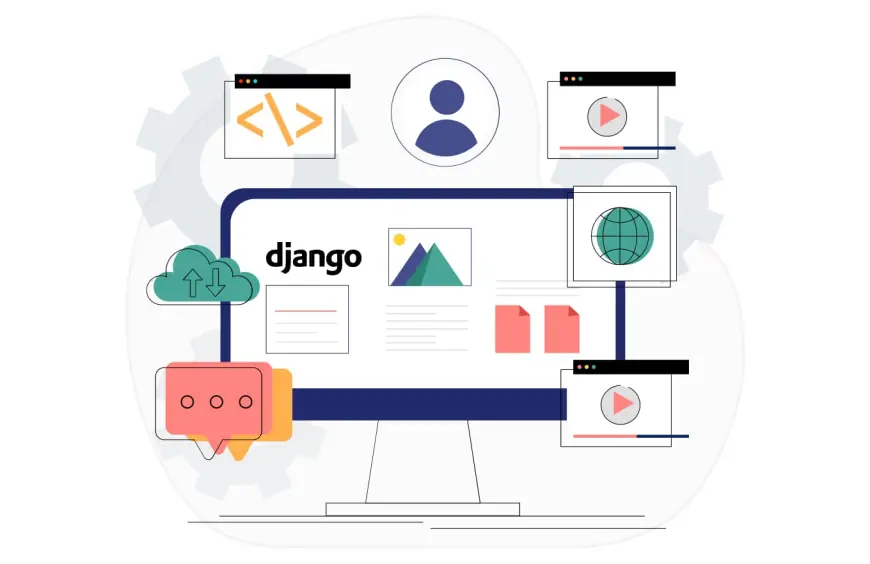What is Django and How Does it Works
Learn what Django is and how it works. Discover its features, architecture, and how it simplifies building secure, scalable web applications.

It is one of those Python frameworks that that follows the Model-View-Template architectural pattern and emphasizes rapid development and clean, pragmatic design!
According to the 2024 Stack Overflow Developer Survey, Django ranks as the 9th most popular web framework on a whole. It is the most popular web development framework after Flask according to 2020 Python Developers Survey. While not the top framework, Django maintains a strong and active community, offering robust features for web development. Pinterest, Spotify, Disqus, NASA, Eventbrite - are Django example applications.
Python programming language, for backend coding requires Django web framework for seamless application development. But it does not restrict it to do that. Django is a powerful web framework, but there are several tools and libraries that can supplement it and enhance its functionality.
I am Going To Dissect Django Here..
For frontend development JavaScript frameworks - React, Vue.js, or Angular are used to build dynamic and interactive user interfaces that integrate with Django's backend. CSS frameworks -
Bootstrap, Tailwind CSS, Bulma, Materialize CSS, and Foundation help styling the Django applications quickly and consistently. Django comes with its own templating engine, consider Jinja2 for its more flexible syntax and features.
For testing, a popular testing framework pytest - a simple and powerful way to write tests for your Django applications is used. Django-selenium integrates Django with Selenium for browser-based testing. Factory_boy generates test data. Redis, Celery, WebSockets allow real-time features in applications. Django-allauth simplifies user account management for security. Django-guardian implements object-level permissions in Django. Django-cors-headers enables Cross-Origin Resource Sharing (CORS) for your Django applications. Django-rest-framework is used for building RESTful APIs with Django. Django-debug-toolbar is used for debugging Django applications. Django-extensions is a set of useful extensions for Django. Django-crispy-forms helps improve the appearance of Django forms.
Are you Still Clear, Where Did it Come from and What Does it do?
In the world of code, a framework stands tall, Django, a tool that answers the call. A Python creation, both powerful and sleek, for building web apps, it's all you seek.
With a model-view-controller to guide the flow, Django keeps things organized as your project grows. The request hits the server, the view takes its place, returning the response, a seamless embrace.
It comes with features, robust and vast - authentication, admin, and security, fast. ORM for databases, URLs with ease, templating and forms, and web development services to handle with peace.
From blogs to e-commerce, it’s versatile and true, best for large sites, or when scalability’s due.
For rapid development, where time is a friend, Django’s the framework that will never bend.
So if you’re building web apps, don't hesitate, Django’s the tool to make your work great.
Django Takes Exception Here..
Django has a lot of built-in features, which is overwhelming for beginners. Understanding the framework's structure and conventions takes time and effort.
While it is high-performing framework, it does not work so well for specific use cases like high-traffic websites or complex data processing because it comes with a lot of built-in features and abstractions essentially providing most of the tools needed to build a full-fledged web application right out of the box, without requiring many external third-party libraries; this often includes features like user authentication, database management, templating, and an admin interface, allowing developers to focus on the unique aspects of their project rather than setting up basic infrastructure from scratch.
Structuring a large, ongoing, mature Django project might be a problem. Also writing complex Django applications with a services layer might get time consuming, adding overhead when you only need a small subset of functionality for a highly specialized task.
Django's Object-Relational Mapper simplifies database interactions, but it can sometimes be less efficient or flexible than writing raw SQL queries.
But the Future Looks Bright..
While Django offers a robust set of features for rapid development, security, scalability, and a strong community, a potential area to consider is its "opinionated" nature, which can sometimes limit flexibility for highly customized projects requiring a lot of non-standard functionality. Compared to more lightweight frameworks like Flask, Django's extensive built-in features and strict structure can present a steeper learning curve for developers new to web frameworks or Python, potentially making Django less ideal for small, simple applications where a more flexible approach might be more efficient. While Django allows for customization, its strong opinions on how things should be done can sometimes restrict developers who want to implement unique solutions that deviate from the standard patterns. Although scalable, very high-traffic applications might require additional optimization beyond what Django provides out of the box, depending on the specific requirements.
How Does Django Work?
Each Django application (building block for web apps or website) typically has its own models, views, templates (via Django templating language that combines Python and HTML) and URLs, organized in a specific directory structure. Django development companies can reuse Django applications across different projects, making development more efficient. Applications help in breaking down the project into smaller, manageable components, making it easier to maintain and understand.
Django framework is used for user authentication, managing blog posts, comments, and categories; providing shopping cart functionality, product management, and order processing; creating an interface for other applications to interact with your data.
What Does a Basic Django Project Look Like?
Play the python manage.py startapp myapp startapp command to create a new Django application. This creates a new directory called myapp with structure:
myapp/
__init__.py
admin.py
apps.py
migrations/
models.py
tests.py
views.py
Install third-party Django applications from the Python Package Index using pip install django-allauth It is like installing a popular authentication app. Once installed, name the application, structure the files logically, consider dependencies to organize the project. Conduct thorough unit tests in a development environment, then move to a staging environment for integration testing with other components, and in the end deploy to production after comprehensive quality checks.
Python framework Django facilitates testing of views, models, and components. These must be isolated during testing so that issues can be pinpointed easily. Integrate the test cases into a continuous integration pipeline to automatically run with every code change.
Conclusion
Django development services have to create similar applications with common functions - authentication, information retrieval from a database, and cookie management. Django development services create streamlined web applications for common functions like user authentication, database interaction, and cookie management, effectively eliminating the need for developers to write repetitive code for these core features in every new project, allowing them to focus on the unique aspects of each application and deliver efficient solutions faster.












